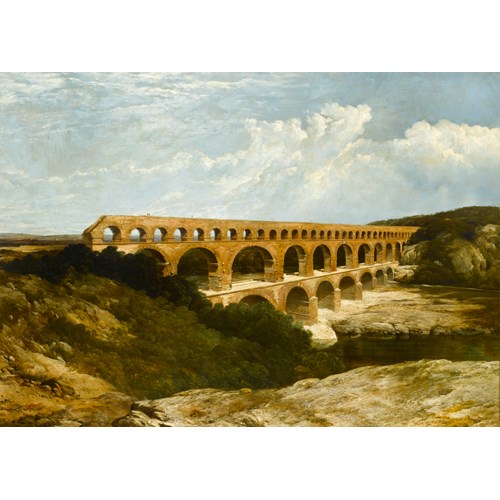Nicolaes Maes
Portrait of a Gentleman, Three-Quarter Length, in a Brown Tunic with a Red Cloak in a Wooded Landscape, at Sunset
Date 1676
Epoque 1600-1750, 17th century
Origine The Netherlands
Medium Oil on canvas
Dimension 54.9 x 46 cm (21⁵/₈ x 18¹/₈ inches)
The sitter is posed nonchalantly with one arm akimbo and the other propped up against a mossy rock. His hair is worn long with luxurious curls falling below his shoulders, which matched by the brightness of his eyes, the smoothness of his skin and the hint of facial hair above his upper lip, indicate that he is a very young man. He wears a simple and elegant informal garment known as a vest in the seventeenth century. It fastens at the chest with decorative clasps, revealing his shirt underneath in a fashionably negligent manner. Dominating the composition is the gentleman’s requisite cloak which wraps around his shoulders, falling in luminous folds and giving him a classical air. The sitter is obviously aspiring towards a romantic look in his choice of dress and hairstyle and in the dramatic nature of his surroundings. The grotto he shelters under is appropriately dark, craggy and overgrown, and the ivy tendril climbing up the rock at the left of the painting adds to the lyricism of the scene.
Maes’ Portrait of a Young Woman in the Hermitage was painted two years after the present painting, and reveals similar choices in composition and palette. Maes’ portraits of this period clearly favour red, gold, brown, ochre and russet tones, all of which were very much in vogue towards the end of the seventeenth century. The young woman in the Hermitage portrait is posed against a backdrop of sumptuous red drapery, emphasizing a soft femininity, while the surroundings of the present portrait suggest masculine vigour and poetic sensibility. In both portraits, Maes is clearly influenced by the paintings of Sir Anthony van Dyke who decades earlier mastered the skill of portraying his subjects with casual elegance and timeless grace by generalising dress details and focusing on the lustre and richness of the fabrics.
Born in Dordrecht, Maes spent his late twenties studying under Rembrandt in Amsterdam before returning to Dordrecht and establishing himself as an independent painter around 1653. Maes’ employment of colour, chiaroscuro and brushwork, particularly in his early paintings of religious and genre subjects, is clearly inspired by Rembrandt. Gradually Maes increased his production of portraiture and by the 1660s devoted himself exclusively to painting people’s likenesses. His output during the 1670s and 1680s was prolific. He settled for good in Amsterdam in 1673, where he became a highly sought after artist, filling a void after the deaths of portrait specialists Bartholomeus van der Helst and Abraham van den Tempel. A favourite format employed by Maes during this period was the three-quarter length portrait, with the sitter leaning against a rock or column, in natural surroundings, with a setting sun in the distance, as exemplified by both works discussed here.
A note on provenance: William Berry (1879-1954), created 1st Viscount Camrose in 1941, controlled the largest media empire of his day, owning the Sunday Times, Financial Times and Daily Telegraph, as well as other newspapers and magazines. In 1935 he bought Hackwood Park, built for the 1st Duke of Bolton at the end of the seventeenth century and altered by Samuel and Lewis Wyatt in the early nineteenth century. The heirs of the Duke of Bolton had let Hackwood between 1850 and 1935, so Camrose also acquired much of the original furniture and contents. This he complemented, continued by his son, John Berry, 2nd Viscount Camrose (1909-1995), with a fine collection of Old Master and later paintings, including most notably Van Dyck's Portrait of the Abbé Scaglia (National Gallery, London; inv. no. 6575)
Date: 1676
Epoque: 1600-1750, 17th century
Origine: The Netherlands
Medium: Oil on canvas
Signature: Signed and dated ‘MAES. 1676’ (lower left).
Dimension: 54.9 x 46 cm (21⁵/₈ x 18¹/₈ inches)
Provenance: with Leggatt, London, 1929.
Sir William Ewert Berry, 1st Viscount Camrose (1879-1954), Hackwood Park, Basingstoke, by whom bequeathed with Hackwood to his son
Sir John Seymour Berry, 2nd Viscount Camrose (1909-1995);
Christie's, London, 9 July 1999, lot 44.
Anonymous sale [The Property of a Gentleman], Sotheby's, London, 10 July 2003, lot 135;
Private Collection.
Literature: Richard Haslam, ‘Hackwood Park, Hampshire – II’, in Country Life, December 17 1987, p.59, illustrated;
L. Krempel, Nicolaes Maes, Berlin 2000, p. 318, cat. no. A 181, reproduced plate 249.
Plus d'œuvres d'art de la Galerie









